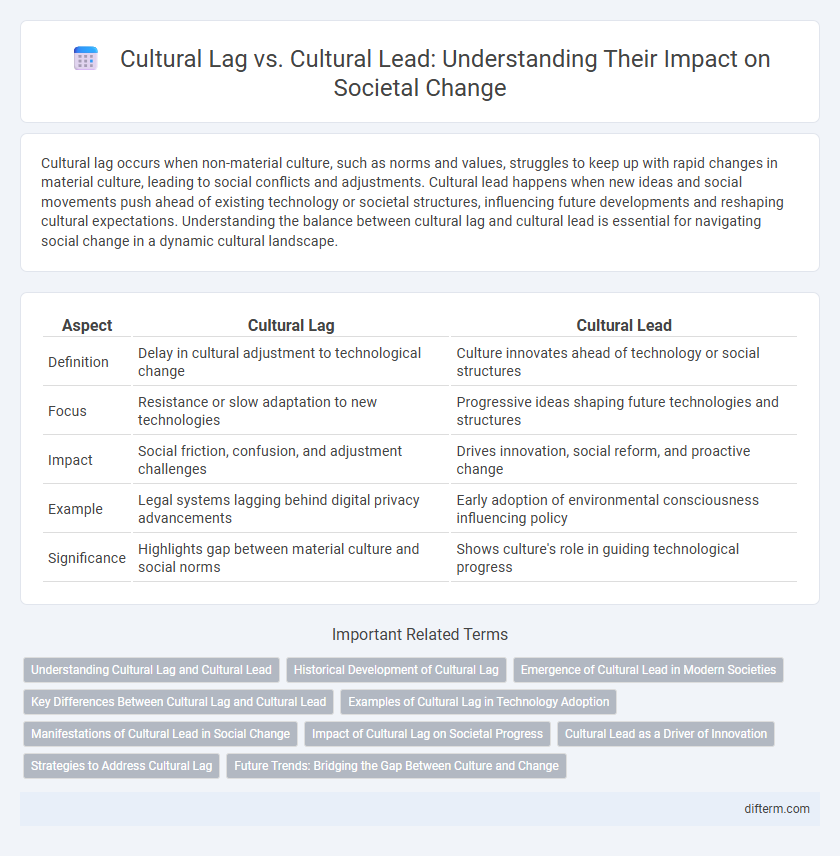Cultural lag occurs when non-material culture, such as norms and values, struggles to keep up with rapid changes in material culture, leading to social conflicts and adjustments. Cultural lead happens when new ideas and social movements push ahead of existing technology or societal structures, influencing future developments and reshaping cultural expectations. Understanding the balance between cultural lag and cultural lead is essential for navigating social change in a dynamic cultural landscape.
Table of Comparison
| Aspect | Cultural Lag | Cultural Lead |
|---|---|---|
| Definition | Delay in cultural adjustment to technological change | Culture innovates ahead of technology or social structures |
| Focus | Resistance or slow adaptation to new technologies | Progressive ideas shaping future technologies and structures |
| Impact | Social friction, confusion, and adjustment challenges | Drives innovation, social reform, and proactive change |
| Example | Legal systems lagging behind digital privacy advancements | Early adoption of environmental consciousness influencing policy |
| Significance | Highlights gap between material culture and social norms | Shows culture's role in guiding technological progress |
Understanding Cultural Lag and Cultural Lead
Cultural lag occurs when non-material culture, such as values and norms, fails to keep pace with technological advancements, resulting in social challenges and resistance to change. Cultural lead happens when social ideas, norms, or values advance ahead of technological development, often inspiring innovation but also creating tension with existing systems. Understanding cultural lag and cultural lead is essential for managing societal change and aligning technology with cultural adaptation.
Historical Development of Cultural Lag
Cultural lag originates from sociologist William F. Ogburn's theory explaining the delay between technological innovations and the adaptation of cultural norms. Historically, rapid technological advancements during the Industrial Revolution intensified this lag as society struggled to adjust laws, values, and social practices to new realities. This concept highlights how material culture often outpaces non-material culture, causing periods of social tension and transformation.
Emergence of Cultural Lead in Modern Societies
The emergence of cultural lead in modern societies reflects the proactive adaptation of social norms, values, and technologies ahead of existing infrastructures and regulations. This phenomenon accelerates innovation by anticipating future needs and fostering transformational changes in education, communication, and governance. Cultural lead drives progressive shifts that shape societal evolution, contrasting with cultural lag where outdated systems delay progress.
Key Differences Between Cultural Lag and Cultural Lead
Cultural lag occurs when material culture advances faster than non-material culture, causing social conflicts and adjustment challenges, whereas cultural lead happens when non-material culture, such as values and beliefs, evolves ahead of material changes, driving innovation and social reform. The key difference lies in their temporal dynamics: cultural lag reflects a delay in societal adaptation, while cultural lead represents proactive cultural shifts influencing technological or structural developments. Understanding these concepts helps explain social change patterns and the tension between tradition and modernization.
Examples of Cultural Lag in Technology Adoption
Cultural lag occurs when society's values, norms, and laws fail to keep pace with rapid technological advancements, such as the slow adoption of privacy regulations in response to social media platforms and data collection practices. Another example is the resistance to autonomous vehicles due to safety concerns and ethical debates despite ready technology and pilot programs. These delays in cultural adaptation can result in legal ambiguities and ethical challenges that hinder the full benefits of technological innovation.
Manifestations of Cultural Lead in Social Change
Cultural lead manifests in social change through proactive adoption of innovative technologies and progressive social values before widespread acceptance. Societies exhibiting cultural lead often drive reforms in education, gender equality, and environmental policies, setting new norms that others eventually follow. This anticipatory adaptation accelerates development and influences global cultural trends by shaping future societal expectations.
Impact of Cultural Lag on Societal Progress
Cultural lag occurs when material innovations outpace non-material culture, leading to social conflicts and resistance to change. This lag slows societal progress by creating disparities in values, norms, and laws compared to technological advancements. The resulting tension can hinder effective policy implementation and socio-economic development.
Cultural Lead as a Driver of Innovation
Cultural lead represents a society's ability to adopt new technologies and ideas ahead of widespread social adaptation, acting as a key driver of innovation by fostering early acceptance and integration of change. This proactive embrace accelerates technological progress and reshapes social norms, creating competitive advantages in economic and creative sectors. By prioritizing cultural lead, communities generate dynamic environments where emerging innovations rapidly influence behavior and institutional structures.
Strategies to Address Cultural Lag
Organizations can address cultural lag by implementing continuous education programs that promote awareness of technological and societal changes, ensuring values and practices evolve accordingly. Strategic integration of feedback mechanisms allows cultures to adapt proactively by identifying friction points between existing norms and emerging innovations. Leveraging change management frameworks such as Lewin's Change Model or Kotter's 8-Step Process enhances the alignment of cultural values with advancing technologies, minimizing resistance and promoting cultural lead.
Future Trends: Bridging the Gap Between Culture and Change
Cultural lag occurs when technological advancements outpace societal norms, creating a disconnect that can hinder adaptation to future trends. Cultural lead describes societies proactively shaping values and behaviors to anticipate change, promoting smoother integration of innovation. Bridging this gap requires fostering continuous dialogue between cultural institutions and emerging technologies to ensure harmonious evolution.
Cultural Lag vs Cultural Lead Infographic

 difterm.com
difterm.com